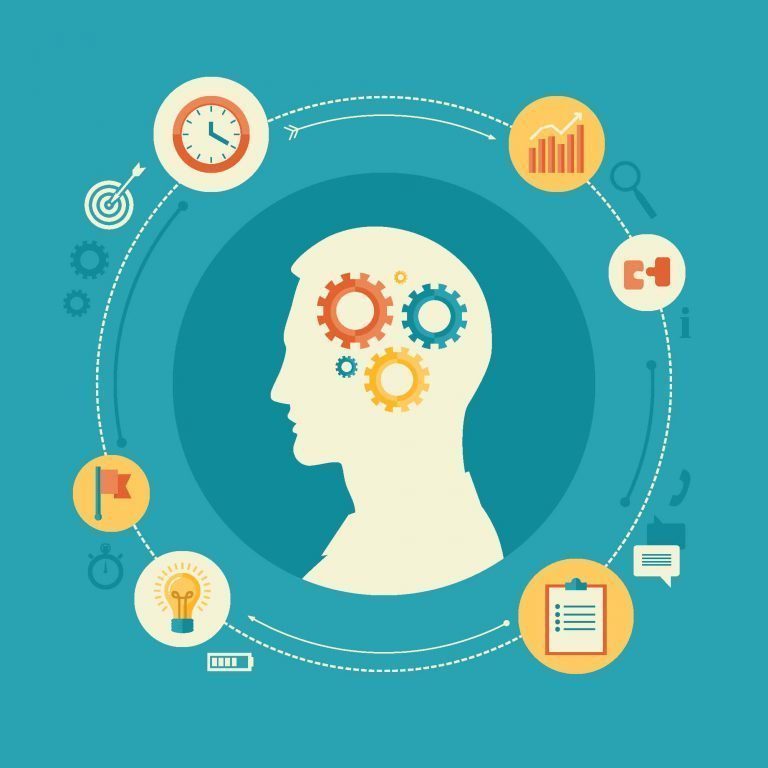0
You have 0 items in your cart

We all have different ideas of how to be a high-performance leader. What creates productivity, creativity & efficiency in a team? Well, productivity can be fueled by a change of Mindset. What is mindset? The idea of mindset was discovered by Stanford University, Carol Dweck after several years of research. It is considered to be a simple idea that can make all the difference.
In her research, Carol Dweck outlines that there are two types of mindset: fixed mindset and growth mindset. People with a fixed mindset believe that their qualities are fixed traits. They believe that their talents or intelligence cannot grow. With this type of mindset, these people tend to spend most of their time documenting what they have done with their fixed traits. Their fixed mindset makes them believe that talent, not hard work, can only achieve success.
 On the other hand, people with growth mindsets are people who believe that with hard work and dedication, their basic abilities can be improved. People with a growth mindset view talent and intelligence as a starting point, and they then focus on improving their capabilities. They never yield to their failures or setbacks, but they view them as an opportunity learn and grow.
On the other hand, people with growth mindsets are people who believe that with hard work and dedication, their basic abilities can be improved. People with a growth mindset view talent and intelligence as a starting point, and they then focus on improving their capabilities. They never yield to their failures or setbacks, but they view them as an opportunity learn and grow.
Whether you are aware of it or not, we keep running an account of what is happening around as and how productive we are. Our minds are always monitoring and interpreting the situations around us, and depending on our mindset these situations can affect us either positively or negatively. Our mindset will govern our interpretation process. A fixed mindset will focus on judging situations in a negative manner. For instance, the fixed mindset will say ‘I don’t fit in here’ or ‘My boss is too demanding’. Because of this, your production will definitely go down as your self-esteem will go down.
Elements of our personality such as sensitivity to failure/setback can predispose us to holding a particular mindset. The good news is that we have the ability to develop and reshape our mindsets. We can transform our mindset from fixed to growth to increase our productivity.

When we believe that we cannot grow, we can’t. When you have a fixed mindset, you cannot explore possibilities. You will always give up easily and you will not achieve your goals easily. The growth mindset is based on the ability to develop, change and explore new heights that have not been explored before.
You can develop a growth mindset if you practice. Remember, change is not an event but it is a process.
By using the above practices, you will slowly transform from a fixed mindset to a growth mindset and your productivity will grow.
Productivity is never an accident, it’s the result of a commitment to excellence, intelligent planning & focused effort
 We have at one point in our life received praise for the good we have done and as well been blamed for something gone wrong. We are familiar with the effects of the two; which effect was long lasting? Which of the two made you feel more productive and which inspired you to become even more determined? In a work environment, praise, blame and criticism are tools that if used properly can lead to higher productivity. The vice versa is true, if criticism, praise or criticism is used wrongly, the productivity of workers tend to nosedive which can bring devastating effects to your business.
We have at one point in our life received praise for the good we have done and as well been blamed for something gone wrong. We are familiar with the effects of the two; which effect was long lasting? Which of the two made you feel more productive and which inspired you to become even more determined? In a work environment, praise, blame and criticism are tools that if used properly can lead to higher productivity. The vice versa is true, if criticism, praise or criticism is used wrongly, the productivity of workers tend to nosedive which can bring devastating effects to your business.
Praise, if used correctly, makes employees become more creative and have less stress while working. This converts to higher productivity. When reminded of a good thing they have done, employees get motivated and work even harder to surpass their previous achievement. In a study that involved more than 4 million employees carried out by The Gallup Organization, employees who received regular praise for their achievements:
The research showed that, workers working for a boss they disliked they were more likely to develop stress related problems. They also exhibited low productivity in the workplace despite being busy all the time. Such workers did not intend to suggest developmental ideas, as they are wary of their boss.
 Productive praise should be specific, outline why you are praising your employee other than just a routine ‘well done’. Additionally, do not praise everything, it becomes devalued and meaningless and its impact is no more. When you praise too much, you shift from productive praise to destructive praise. Another aspect of destructive praise is extreme praise. For instance, if you tell someone ‘You are a natural’ the person will feel so good at something that they will stop trying being better. This will definitely lower productivity. For praise to be productive, do not add conditions to your praise or use it as a sweetener to negative feedback. Praise is a very effective tool that if used wisely can lead to increased motivation and better results in the workplace.
Productive praise should be specific, outline why you are praising your employee other than just a routine ‘well done’. Additionally, do not praise everything, it becomes devalued and meaningless and its impact is no more. When you praise too much, you shift from productive praise to destructive praise. Another aspect of destructive praise is extreme praise. For instance, if you tell someone ‘You are a natural’ the person will feel so good at something that they will stop trying being better. This will definitely lower productivity. For praise to be productive, do not add conditions to your praise or use it as a sweetener to negative feedback. Praise is a very effective tool that if used wisely can lead to increased motivation and better results in the workplace.
If something does not go as expected at the workplace, someone has to take the blame. Depending on how the blame is laid, it can encourage the person to style up and avoid the same mistake again. This is where constructive criticism knocks; constructive criticism focuses on the achievable objectives, has a positive tone and aims at boosting productivity. On the other hand, destructive criticism demeans, discourages and condemns people.
 To criticize constructively, use a self-assessment approach by skillful questioning which makes the other party to recognize their mistakes and learn. When you guide an appraisee to point out their mistakes, they learn and will avoid making the same mistakes. However, if you point the mistakes yourself, they will only get emotionally hurt, their self-esteem will go down and their overall productivity will decrease.
To criticize constructively, use a self-assessment approach by skillful questioning which makes the other party to recognize their mistakes and learn. When you guide an appraisee to point out their mistakes, they learn and will avoid making the same mistakes. However, if you point the mistakes yourself, they will only get emotionally hurt, their self-esteem will go down and their overall productivity will decrease.
Do not focus on the person who did the mistake, when criticizing; instead focus on the mistake itself. For instance, if an employee makes a mistake and the boss comments ‘You are always making mistakes, I wonder why you are here in the first place’. Though it might be said with good intentions, the employee will be hurt beyond measure and his or her productivity will go down. Instead, be descriptive, use apathetic tone and show that the person is not the problem, but the behavior or results are. At the same time, do not impose solutions. Instead, use the self-assessment trick-use questions to draw the appraisee to a solution as he will learn better.
Best-self activation is an all-encompassing tool that leads to immediate and long-term desirable outcomes through interaction, recursion and subjective construal between social system and social concept. Best-self activation concepts lead to improvements in employee’s productivity, emotions, resilience to burn out and stress normally associated with the work environment. Creativity in problem solving, good relationships with colleagues and employers, high performance under pressure are some of the benefits associated with best-self activation.
 Best-self activation influences physiology and emotions in employment relationships. There is growing evidence which suggest that apart from making workers feel good, best-self activation also makes them experience a barrage of positive emotions like happiness, joy, numerous intellectual, social and physical benefits. A reflected best-activation equips employees with novel input from their social network about the reality of their personality and yearns to make the maximum contribution possible. This intervention sharpens the individual’s best-self-concept which are the cognitive representation of the characteristics and qualities the employee will display in his or her best during the course of discharging their duties. Increasing the accessibility to best –self activation concepts is an intervention which significantly change individuals’ self-knowledge structures which are critical in explaining why and how people do and feel in and out of the work environment.
Best-self activation influences physiology and emotions in employment relationships. There is growing evidence which suggest that apart from making workers feel good, best-self activation also makes them experience a barrage of positive emotions like happiness, joy, numerous intellectual, social and physical benefits. A reflected best-activation equips employees with novel input from their social network about the reality of their personality and yearns to make the maximum contribution possible. This intervention sharpens the individual’s best-self-concept which are the cognitive representation of the characteristics and qualities the employee will display in his or her best during the course of discharging their duties. Increasing the accessibility to best –self activation concepts is an intervention which significantly change individuals’ self-knowledge structures which are critical in explaining why and how people do and feel in and out of the work environment.
It’s not about being the best, it’s about being better than you were yesterday
 From the social network point of view; a positive impact creates positive emotions (People will become joyful when they receive a pleasant surprise). The same case applies when people get inspired whenever they witness fellow human’s excelling. In a nutshell, best-self activation acts as a media of information about a person at their best. This theoretically promotes positive emotions namely; pride, awe, joy, compassion, inspiration and excitement. It is thus hypothesized that employees who receive best-self activation experience greater positive emotions in comparison to those individuals who don’t receive best- self activation.
From the social network point of view; a positive impact creates positive emotions (People will become joyful when they receive a pleasant surprise). The same case applies when people get inspired whenever they witness fellow human’s excelling. In a nutshell, best-self activation acts as a media of information about a person at their best. This theoretically promotes positive emotions namely; pride, awe, joy, compassion, inspiration and excitement. It is thus hypothesized that employees who receive best-self activation experience greater positive emotions in comparison to those individuals who don’t receive best- self activation.
Psychology has it that positive emotions greatly broaden people’s scope in terms of awareness. This leads to wider array of actions, thoughts and perceptions. This broadens the mindset to the basic discovery of entirely new knowledge, forging of new alliances and acquisition of new skills. One useful result of the broadened mindset in best –self activation is the undoing effect concept. This refers to the process in which positive emotions takes to pieces and dismantles the effects of stress and other negative emotions. Positive mindset enables individuals to cope and evaluate stress which subsequently makes them more resilient. Normally employees tend to direct their attention on the immediate threat which is a response geared to promote self-protection. Stress in the work place can extensively impair their cognitive functioning and lower their productivity. Psychologically, best-self activation should undo the cardiovascular response to negativity to the baseline levels. This increases employee’s resilience to stress even if they are working under very stressful conditions or circumstances.
 The stress resilience and broadening effect is an inevitable consequence of best-self activation concepts which in turn improves creativity and problem solving. When employees are less encumbered by reactions to threat and stress, they are better placed to marshal their cognitive faculties to meet the task at hand through exertion of self-control. Individuals who receive best-self activation are better placed to perform better and solve problems in very stressful conditions compared to their counterparts who never received the best-self activation.
The stress resilience and broadening effect is an inevitable consequence of best-self activation concepts which in turn improves creativity and problem solving. When employees are less encumbered by reactions to threat and stress, they are better placed to marshal their cognitive faculties to meet the task at hand through exertion of self-control. Individuals who receive best-self activation are better placed to perform better and solve problems in very stressful conditions compared to their counterparts who never received the best-self activation.
Social system effects act through interaction with other environmental processes. Best-self activation gives early advantages in terms of negotiation, perpetuation and broadening of the employee’s scope. This raises creativity and engagement since they are better placed to tackle challenges and well placed to embrace new opportunities as they arise. Subjective construal and interpretation of the environment are interventions which are as a consequence to best-self activation. This has lasting effects in changing people’s narratives concerning their social environment in the work place and their associated attitudes and behaviors.

In today’s competitive economic landscape, it is imperative to have happy, motivated and productive employees to have an edge. When employees are disengaged, disloyal, undervalued and overworked then it proves an uphill task to break even leave alone to making profits.
The benefits of these breaks are to keep the employees from becoming bored and unfocused. When in the groove of a project or task, ideas flow and the feeling is fantastic. This unfortunately does not last forever and each time you stretch beyond your productivity zone, you get exhausted, unfocused, and irritable and zoned out. To fix this is simple, let the employee take a break and they will come back on tract. Scientifically it has been shown that deactivation and reactivation of goals especially when faced with long tasks it is necessary to take breaks to keep one focused and on track.
 Breaks help the employees to make new connections and retain information. The brain is conditioned on two models. The focused mode and the diffuse mode; the latter is the more relaxed and not associated with hard thinking while the former entails learning and meticulous execution of task. To help optimize the employee’s productivity in the work place regular breaks will do the trick. This is based on the premise that breaks allows the brain to hook up novel and return valuable insights. When you are on the focus mode you actually block access to diffuse mode. This will enable them to be able to systematically solve very difficult problems and be prepared to tackle challenging tasks throughout the day.
Breaks help the employees to make new connections and retain information. The brain is conditioned on two models. The focused mode and the diffuse mode; the latter is the more relaxed and not associated with hard thinking while the former entails learning and meticulous execution of task. To help optimize the employee’s productivity in the work place regular breaks will do the trick. This is based on the premise that breaks allows the brain to hook up novel and return valuable insights. When you are on the focus mode you actually block access to diffuse mode. This will enable them to be able to systematically solve very difficult problems and be prepared to tackle challenging tasks throughout the day.
Breaks help the employees to re-evaluate their tasks and goals. The benefits of breaks in any organizational set-up cannot be under-estimated. The breaks allow the employees to take a back step and ascertain that they are accomplishing their goals in the right way. When worked continuously, the employees lose focus and are likely to be lost in the weeds. On the other hand, following brief intermission and picking from where they left will enable them to think and reflect on what they really want to achieve. This practically encourages them to stay focused and mindful of their expectation and objectives.
To keep employees working and happy it is important to make them feel that they are an essential part of the organizational set-up. Smart organizations’ primary goal is the enhancement of employee performance. Knowledge of the work economy is based on the premise that employees are the fuel that keeps organizations adapting, growing, innovating and improving. Breaks positively affect the ability of the employee by enabling the individual to adjust to the negative impact associated with recurrent and tiring activities which are most uncomfortable, noxious and distracting. The breaks motivate employees through psychological engagement and effective functioning. This boosts their mood and morale, which in turn enhance their performance at the work place.
 Working alone in the workplace can be exhausting, let alone boring. Working as a team increases productivity, as there are more minds. Working as a team encourages innovation in the workplace giving your business incentives to move forward. Additionally, working as a team induces a more positive attitude to the employees. Teamwork in the workplace leads to happier and more productive workers.
Working alone in the workplace can be exhausting, let alone boring. Working as a team increases productivity, as there are more minds. Working as a team encourages innovation in the workplace giving your business incentives to move forward. Additionally, working as a team induces a more positive attitude to the employees. Teamwork in the workplace leads to happier and more productive workers.
For any organization to thrive, remain competitive and satisfy the customers ever changing needs, it must learn how to get the most of their employees through team working.
Words of encouragement from the employer go a long way in improving the employee’s productivity. By encouraging your employees, they feel valued and the workplace becomes a happy place to be. When your employees achieve their goals, make a point of rewarding their efforts. Setting up a system to award your employees is an excellent way of increasing productivity. This will give them incentives and improve overall productivity at the workplace.
 Creating a work friendly environment motivates your employees as they feel that they are where they belong. Enough working space, air conditioning and comfortable working stations contribute to a work friendly environment. You can also create good relationships with your employees by organizing few social events in the workplace such as a pizza day. These practices make your employees feel valued and their productivity increases.
Creating a work friendly environment motivates your employees as they feel that they are where they belong. Enough working space, air conditioning and comfortable working stations contribute to a work friendly environment. You can also create good relationships with your employees by organizing few social events in the workplace such as a pizza day. These practices make your employees feel valued and their productivity increases.
Productivity is the result of focused efforts, motivation and intelligent planning. It can also be defined as the efficiency of converting inputs to outputs. With a growth mindset, best-self activation, productive praise, constructive criticism and breaks, productivity can be improved. However, if these tools are not used wisely, productivity cannot be achieved. It is therefore a viable idea to master the art of using these tools to improve productivity at your workplace.
Productivity is not just about doing more, it is about creating more impact with less work
This Privacy Policy describes how SmartMinds Enterprise OÜ (“SmartMinds”, “we”, “us” or “our”) handles information about yourself that you may provide us with through your use of the Site or Service (“Personal Information”) and should be read along with our Terms of Use posted here, and all other operating rules and additional terms and conditions published on our Site.
SmartMinds is committed to keeping your information secure and managing it in accordance with our legal responsibilities under privacy and data protection laws where we operate. SmartMinds uses your Personal Information only in accordance with this Privacy Policy and Applicable Law. SmartMinds does not sell your Personal Information to third parties. Any capitalized terms not defined in this Privacy Policy are defined in the Terms of Use.
We employ the use of cookies. By using SmartMinds‘s website you consent to the use of cookies in accordance with SmartMinds’s privacy policy.
Most of the modern day interactive web sites use cookies to enable us to retrieve user details for each visit. Cookies are used in some areas of our site to enable the functionality of this area and ease of use for those people visiting. Some of our affiliate / advertising partners may also use cookies.
Unless otherwise stated, SmartMinds and/or it’s licensors own the intellectual property rights for all material on SmartMinds All intellectual property rights are reserved. You may view and/or print pages from https://smartminds.one for your own personal use subject to restrictions set in these terms and conditions.
You must not:
We will approve link requests from these organisations if we determine that: (a) the link would not reflect unfavourably on us or our accredited businesses (for example, trade associations or other organisations representing inherently suspect types of business, such as work-at-home opportunities, shall not be allowed to link); (b)the organisation does not have an unsatisfactory record with us; (c) the benefit to us from the visibility associated with the hyperlink outweighs the absence of SmartMinds; and (d) where the link is in the context of general resource information or is otherwise consistent with editorial content in a newsletter or similar product furthering the mission of the organisation.
These organisations may link to our home page, to publications or to other Web site information so long as the link: (a) is not in any way misleading; (b) does not falsely imply sponsorship, endorsement or approval of the linking party and its products or services; and (c) fits within the context of the linking party’s site.
If you are among the organizations listed in paragraph 2 above and are interested in linking to our website, you must notify us by sending an e-mail to Please include your name, your organisation name, contact information (such as a phone number and/or e-mail address) as well as the URL of your site, a list of any URLs from which you intend to link to our Web site, and a list of the URL(s) on our site to which you would like to link. Allow 2-3 weeks for a response.
Approved organizations may hyperlink to our Web site as follows:
No use of (name)’s logo or other artwork will be allowed for linking absent a trademark license agreement.
Without prior approval and express written permission, you may not create frames around our Web pages or use other techniques that alter in any way the visual presentation or appearance of our Web site.
We shall have no responsibility or liability for any content appearing on your Web site. You agree to indemnify and defend us against all claims arising out of or based upon your Website. No link(s) may appear on any page on your Web site or within any context containing content or materials that may be interpreted as libelous, obscene or criminal, or which infringes, otherwise violates, or advocates the infringement or other violation of, any third party rights.
We reserve the right at any time and in its sole discretion to request that you remove all links or any particular link to our Web site. You agree to immediately remove all links to our Web site upon such request. We also reserve the right to amend these terms and conditions and its linking policy at any time. By continuing to link to our Web site, you agree to be bound to and abide by these linking terms and conditions.
If you find any link on our Web site or any linked web site objectionable for any reason, you may contact us about this. We will consider requests to remove links but will have no obligation to do so or to respond directly to you.
Whilst we endeavour to ensure that the information on this website is correct, we do not warrant its completeness or accuracy; nor do we commit to ensuring that the website remains available or that the material on the website is kept up to date.
We have a 30-day Money Back Guarantee when purchasing Realized Mind, all we ask if that within the 30 days to complete the learning experience and if you truly feel you did not receive any value from the experience we are happy to refund your payment and close your account.
To the maximum extent permitted by applicable law, we exclude all representations, warranties and conditions relating to our website and the use of this website (including, without limitation, any warranties implied by law in respect of satisfactory quality, fitness for purpose and/or the use of reasonable care and skill). Nothing in this disclaimer will:
The limitations and exclusions of liability set out in this Section and elsewhere in this disclaimer: (a) are subject to the preceding paragraph; and (b) govern all liabilities arising under the disclaimer or in relation to the subject matter of this disclaimer, including liabilities arising in contract, in tort (including negligence) and for breach of statutory duty.
To the extent that the website and the information and services on the website are provided free of charge, we will not be liable for any loss or damage of any nature.
